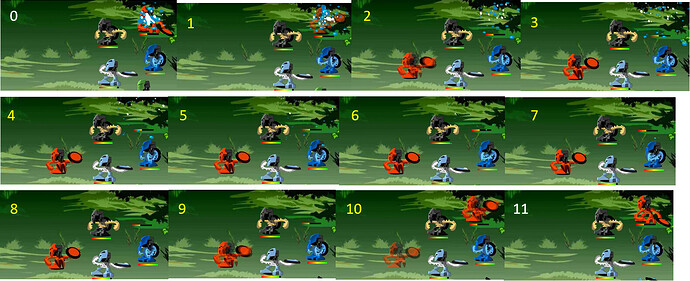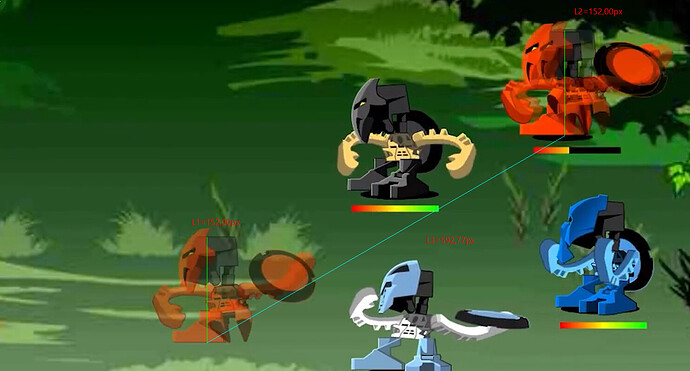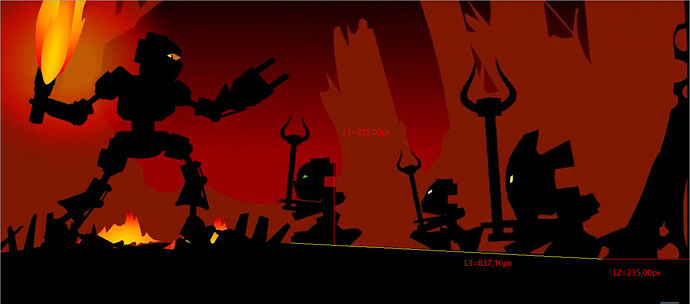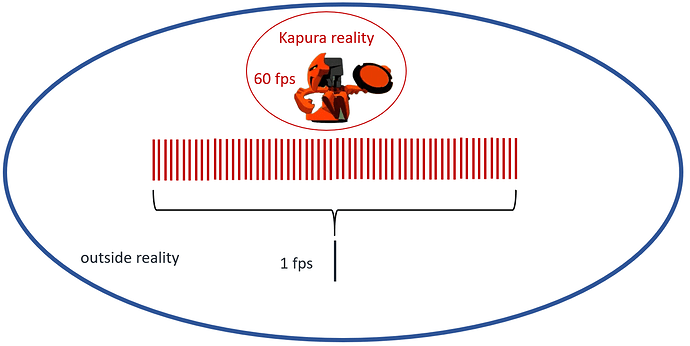This is the ultimate exploration of the 22 year enigma that is Kapura - our favorite Ta-Matoran eccentric weirdo ![]()
![]()
![]()
Everybody knows Kapura: wierd, speaks in riddles and often provides fascinating insight on many aspects of the world. Kapura moves and does things very slowly, but Vakama has faith in his abilities and believes there is more in Kapura than meets the eye. He is not wrong.
With diligent practice Kapura was able to master the Art of traveling great distances by moving very slowly. However he only achieved this during the events of MNOG. This interesting quirk was established in the first Bionicle story bible, but the truth behind it was left up to imagination. During the many years of story, only two groups participating on it, really expanded on this tidbit: Templar Studios and Saffire in MNOG and Legend of Mata Nui respectively.
The intention here is not to establish a definitive answer for the source of Kapura’s abilities (they are meant to be a mystery), but I am going to go over all the pieces of information we have (even very obscure ones) and try to explain the properties and mechanisms of this phenomenon, and make an educated guess at what is probably going on. I am much more interested in the mechanism rather than the origin of Kapura’s Art. Here we go…
First off, we have to acknowledge an immediate suspect - teleportation. This is a very common ability within Matoran Universe (MU) and on the surface level, an obvious candidate for what Kapura is capable of. That said, things are not that simple - there are several different types of teleportation, but it won’t be necessary to discuss them here.
If Kapura’s ability was teleportation, one could come up with a myriad of explanations behind it. Maybe Kapura was experimented on by the Brotherhood or Nynrah and given the power? Did he take a refreshing dip in energized protodermis and happened to be destined for this gift? Or maybe he is the true reason for the Red Star malfunctioning - perhaps he was revived at some point and while being returned back to MU, the teleporter function became linked to his being transporting him whenever he wishes?
Well, wonder no further because the point is moot - as you will see later, Kapura’s ability is definitively NOT teleportation. In fact it has nothing to do with it whatsoever.
So let’s first look at the evidence and information we have. We will have to dig into some weird places, but that should not surprise you when it comes to Kapura…
Relevant MNOG dialogue:
“Vakama says that even though I am slow, I may be faster than all the others, and travel very far. He says I must practice. Jala says I am being silly. I practice often.”
“You are where you are. If I practice, I can be where I am not. I think I can feel it. It is hot here where I am, but where I am not is cold, and I think I can feel it. I must practice more.”
“How did you get here?
It is as Vakama said. I practiced and became skilled. I now know the secret art of traveling great distances by moving very slowly. It is a small matter for me to be wherever I am not. It is a useful skill.”
“If you practice, you can move quickly.”
“Chronicler, it is good of you to come. And thank you, Kapura, fulfilling your mission so quickly. I see that you have indeed gained skill.”
“My left hand is Kapura, who is with you now. He may seem slow and strange to you, but his simple words often carry a hidden wisdom.”
Relevant Legend of Mata Nui dialogue:
"What are you doing here?
I am walking. Vakama says that even though I walk slowly, I may be faster than all the other islanders! Jala says I am being silly. Mata Nui is a large place and I would like to see all of it!"
"How did you get here?
By practicing my special ability!
What is your… special ability?
Vakama says that I am skilled at traveling great distances while walking very slowly."
"Yes Kapura. And you are an amazing individual! How did you cross so much ground so quickly?
Vakama said that I needed to practice my special ability… …perhaps I’m getting good at traveling great distances by walking so slowly.
It seems you have done so. You are a unique individual, Kapura."
So what can we gather from this?
Kapura is regarded by others as strange. His normal speed of movements is slow when compared to others - we see this in his cutscenes in MNOG. Vakama is the only one who initially sees potential in Kapura and tells him to practice. He trusts Kapura enough to make him his left hand. Jaller and others think that Kapura is simply naive and the training won’t make any difference, but Kapura perseveres. He practices often and by the time he must deliver a message to Takua, he finally mastered the “Art” of traveling great distances by walking very slowly. Walking is the important word here, it is our first indication that Kapura is still physically moving (on ground) when he uses his skill. It is after the manifestation of his powers when others recognize Kapura’s skill, first being Vakama. Even the Toa call him an amazing and unique individual.
Important thing to consider is Kapura’s determination - he wishes to travel all across the island and imagines the places he wants to visit and what they feel like. It is thi sensation of a place where he is not, that seems to be the trigger for his ability.
Another notable aspect is that the training is not suppposed to actually make Kapura faster, but to utilize his slow movements for crossing a lot of distance quickly in comparison to others. His actual movement speed should remain the same however - this may seem self-contradictory at first, but as we will see later, it does actually make sense. But first, let’s look at what Greg Farshtey has to say…
Greg’s answers:
Q1: What exactly is “the art of going slow to get somewhere fast” that Vakama is teaching Kapura?
A1: Well, if you knew that, it wouldn’t be a secret anymore… but… I didn’t come up with that, yet it sounds to me like some of the exercises done in Buddhist temples. I used to roleplay with a guy who had studied a lot of Eastern philosophy, and he had us going with a “Bring me a clean bucket” exercise for hours.
Q2: A lot of people on BZP describe Kapura’s relocation ability as teleportation. Is this true or does he just move really fast?
A2: What I know of Kapura is the “get places fastby going slow” thing – I am not aware of him having any teleporation power.
Q3: When Kapura was in space with the others, could he have teleported himself out? I mean, It is as Vakama said, he practiced and became skilled, and he now knows the secret art of travelling great distances by moving very slowly . It is only a small matter for Kapura to be where he is not. It is a useful skill. Where Kapura is, is cold and has no air. Where he is not is overtaken by Makuta and is a city. Could he have been where he was not by moving very slowly?
A3: The problem is, we do not know the range of his powers, we do not know if he needs to be standing on solid ground for them to work, we do not know if he needs to be in line of sight of where he is going … so it may not have been possible for his power to be of any use.
follow up
Q4: I see… Then what would be the range of his powers, would he need to be on solid ground for them to work, and would he need to be in line of sight of where he is going?
So does the mean teleportation with Kapura is canon?
And the most important of all… What does Kapura mean by “moving fast by moving slowly”?
A4: I can’t answer these. This was all part of the 2001 story bible, which was written before I worked at LEGO, and it was never explained what his powers were and how they worked. Since I did very little with Matoran, focusing mainly on Toa, I don’t have this information.
What does Greg’s insight tell us?
While it further removes us from the teleportation interpretation, Greg likens it to the Budhist excercises. Similar things can be found in many of the traditional proverbs like:
“Slow but sure wins the race.”
“The slower you go, the farther you will be.”
It is not about moving fast, but moving surely and steadily to get to the desired location/achieve the goal. I believe Kapura is practicing similar creed aiding him on his journies, however this is not the only factor here. Steady and slow movement would only explain Kapura being an accomplished traveler, but not the fact that he gets everywhere before anybody else. There must be something else at play here in addition to the steadiness and determination.
Greg also raises several interesting questions regarding the functionality and limits of the Art. He himself does not have the answers to them, but we can find those out by analyzing further evidence…
In the MNOG, once the Chronicler’s company sets out on their journey, every member chips in with their skills. Furthermore, at every obstacle, each of them has something interesting to say. There is an instance where the company needs to cross a ravine, but the bridge was destroyed. If you ask Kapura for help, he has this to say:
This is incredibly important! This one sentence answers most of the questions Greg raised in his response. Line of sight has no bearing on Kapura’s Art, missing bridge makes crossing the canyon impossible even for Kapura and the Art cannot overcome this fact. This tells us that Kapura indeed needs to walk on ground and cannot use his ability to get to places he otherwise wouldn’t be able to access. Kapura can only reach locations he can physically travel to by normal means. This along with previous evidence definitevely settles that teleportation is not connected to his ability. Kapura is physically traveling while using the Art.
It explains why Kapura did not use it to return to MU from space - his ability was useless in that case, just like Greg speculated.
Ok, so what we have so far is that the Art is a normal physical movement, which is slow and steady, but when percieved by the others appears to be very fast. How could this be?
This is where we need to dig deeper into obscure media… things are about to get weird. Remember when I said that one of the only story groups who utilized Kapura’s Art was Templar Studios? MNOG was not the only game they made. It’s sequel MNOG II The Final chronicler provides us with the key hint as to the true nature of this power. The info is recorded on BS01:
When playing the game, typing the word “kapura” brings up a box showing the framerate. Pressing numbers on the keyboard causes mysterious things to happen. Pressing ‘2’ creates a green grid that appears all over the screen, and pressing ‘1’ will make it go away. Pressing ‘8’ reloads the screen and fixes any glitches, excluding the Nokama and Le-Koro glitches. The Le-Koro glitch can be beaten another way.
So the people who contributed the most to Kapura’s development think of him as a something that can show the framerate of the “world” (depicted as a game in this case) and alter it in various ways. Hmmm…
With this in mind, what if… what if Kapura’s ability is not some kind of super fast movement (as we already established he should move just as slowly as normally while performing his Art), but Kapura literally alters the “framerate” of the reality around him. This is essentially a mild form of reality warping affecting a single aspect of the world. If we define a single moment as one reality frame, Kapura would utilize his power to slow down the natural framerate of the surrounding reality, while keeping the rate in his immediate vicinity the same. We can visualize this as a sort of personal reality bubble around Kapura where anything inside it keeps operating at the natural framerate and the rest of reality outside the bubble gets slowed down to a lower rate. That way Kapura remains moving at the exact same slow speed, and yet for the outside observer it would seem like he is moving much faster because of the higher relative framerate of the reality surrounding Kapura. With more reality frames nested within a single reality frame of the surrounding world, Kapura has more time to get to places even at his lower speed. The sure and steady movements granted to him by the practice also aid him in traveling long distances at his own pace.
An explanation like this resolves the paradox of Kapura using slow movements to move faster than all others. He is not actually moving faster, but by altering the framerate of the reality, the slow Ta-Matoran gains greater percieved speed.
Let’s move on to analyzing the capabilities of Kapura’s Art at the time he first learned to use it - during the events of MNOG (2001). The online game provides us with one of the only depictions of Kapura performing the Art on-screen, in real time. This is of course during the defend Kini-Nui mini game. Each member of the Chronicler’s company has a dodging maneuver for evading Rahi attacks. They either block the attack with a bamboo disk, jump, or duck out of the way. Only exception is seemingly Kapura who shows something like teleportation, suddenly appearing at a different place and just as quickly reappearing at his original position. However, we now know that it is in fact not teleportation, but another dodge on part of Kapura, percieved as super fast by others.
For the following analysis, I chose a video playthrough of MNOG and looked at the evasive maneuver frame by frame. I have found that the entire animation of this action consists of 10 states and each of them is maintained for several frames. The states are depicted here with state 0 and state 11 being the states before and after the maneuver respectivelly:
We can see that Kapura assumes 3 stationary positions (1-initial, 2-forefront, 3-returned). The states and the number of frames each one lasts (red) are detailed in the table below. Red cells represent the states when Kapura is at the forefront position (dark red is the first state he gets there):
We can see now that the movement from position 1 to position 2 and from 2 to 3 take the exact same amount of frames (7). This makes sense as the distance is identical. 20 frames are spent waiting for the water ball attack to disperse. The entire maneuver (movement back and forth) takes 34 frames. The video used ran at 60 fps and we can use this to calculate the time it took to make this dodge. 34/60=0.5667 s …A little over half a second.
But what we are interested in is the speed of the single movement itself. Since Kapura covers identical distance in both position shifts, I chose the one where the same sprite is present at both positions (state 10) as afterimages. This enabled me to measure the maskless height of Kapura down to a pixel. I then connected the equivalent pixels on the sprites to determine the pixel distance between Kapura’s initial and shifted position.
Dividing the distance with Kapura’s maskless height gives us the amount of maskless body lengths he travelled: 3.8998
Next we need to calculate the absolute distance this represents. I used a real-life size comparison of Toa, Matoran etc. made in stud.io I found online. This should be more precise than measuring physical models. I did not use the measure provided in the picture however, and instead determined the pixel heights of maskless Matoran (340 px) vs Toa (840 px). Using the canon average hight for Toa 1.6 bio [1 bio=1.37 m] we know Toa is 2.1920 m high. A simple calculation using the pixels gives us the 2001 Matoran height of 0.8872 m. Multiplying the number of maskless body lengths with maskless height gives us distance travelled: 3.46 m.
Kapura covered this distance in 7/60=0.1167 s, meaining his speed was 29.657 m/s or 106.735 km/h. Quick search indicates this is similar to averaged sprinting speed for cheetah! That is quite impressive especially when we realize Kapura has instant acceleration and deceleration both on forward and backward movement. He also has practically inexhaustable stamina for this speed because as we know, he isn’t actually sprinting at that speed from his point of view.
Can we determine how much the Art makes Kapura faster compared to his normal unaided speed? Yes!
In the Tahu ambush animation, there is a sequence where Jaller followed by three normal guardsmen runs across the screen which is fixed in position. Kapura runs last. I counted the number of frames each matoran is present on the screen (not counting the spears) and calculated the time it took them.
guard1 - 112 fr.
guard2 - 111 fr. → average of 109.67 fr. → 1.8278 s
guard3 - 106 fr.
Kapura - 340 fr. → 5.6667 s
Kapura is 3.1X slower than an average Ta-Matoran guard.
To determine normal Matoran running speed I used the next shot of guard running toward Tahu. The silhouettes of Tahu and Jaller are alligned and Jaller also coverd most distance, so I used him for this. Starting at the first indication of on-screen presence, I counted the number of frames for Jaller and converted it to time: 158 fr. → 2.6333 s
I measured the maskless body height, distance and body lengths travelled:
1072.16 px equates to 4.7652 body lengths and a distance of 4.23 m.
This makes the running speed of 1.606 m/s or 5.783 km/h for a normal Ta-Matoran. Kapura’s running speed is 3.1X lower, so 0.518 m/s (1.865 km/h).
Finally, dividing the percieved super speed by the unaided speed, we find out that the Art, makes Kapura 57.23X faster. That is quite impressive!
Now, we do not know if this is his maximum performance at the time of the evasive maneuver, but we do know that Kapura can naturally move a little faster than his usual running speed when pushing himself (e. g. the Empire AU) For the sake of convenience and neat numbers, I think it is reasonable to assume he could at least squeeze out the exact 60X multiplier using the Art. With this neat value we conclude Kapura is able to lower the natural framerate of the reality from 60 fps to 1 fps, while he himself continues to operate at 60 fps, and that is why he seems faster to the outside observer.
In the last part of this topic, let’s look at how Kapura continued to improve at his Art over time. In MNOG II, Kapura has this to say to Hahli:
MNOG II dialogue:
I am practicing. Who are you? I am not here, yet I am all places. I am getting faster. Faster? Courage is the soul of movement. You must have courage or you will be frozen. Fear stops all. Courage defeats Fear. Uh, okay. Hello again.
This exchange confirms that Kapura continued to practice his skills even after his rebuilding into a stronger form of 2003 and he is getting faster by the standards of others. We also get a further glimpse into the more metaphysical philosophy behind the Art. Of note is the fact that at the very end of the conversation Kapura greets Hahli again: Hello again. This implies that in between the time Hahli finished her sentence, Kapura travelled someplace else (maybe had an entire adventure) and then came back to Turaga Vakama’s place. When he saw Hahli there he said Hello again. This is the only other time we see the Art being used in real time. In the first MNOG example, the fact that Kapura’s maneuver consisted of multiple states further confirms it was physical movement instead of teleportation, because Greg always described teleporting as instant. However in the second example, we do not see as much as a flicker on the screen. This means that Kapura is now so skilled and impressive that others don’t even notice anything. He has improved from being able to effectively nest 60 reality frames into 1, to nesting some incredibly large unknown amount into 1. Kapura himself even confirms this in his dialogue: “I am not here, yet I am all places. I am getting faster.”
Not here, yet all places… Kapura is able to slow down the reality framerate so much that he can travel to any place on Mata Nui and back within a single reality frame. He has gone from percieved superspeed to percieved omnipresence! While being just as slow as ever… quite impressive.
So that’s it! Like I said I am not going to try explain why Kapura has this ability as this is intentionally mysterious. That said, we do know there are a number of glitched individuals within MU with weird unusual abilities, so Kapura could simply be one of them. Vakama is another mysterious example with his visions of the future. And guess who was the only one to recognize Kapura’s potential…
Final figure:
UPDATE: So I wanted to make a quick update with some more evidence I have gathered in the meantime. I will start with a very fundamental thing. The most fundamental possible actually - we do have an original source of Kapura’s power, the direct quote from the 2000 story bible
provided by Gordon Klimes of Templar studious:
“Alastair Swinnerton and the LEGO story team did an incredible job with the product bible that we worked from, creating everything from the main story of the Toa to the settings and characters, down to (enigmatic) blurbs for the Matoran secondary characters. For example, Kapura’s note in the bible, near the end of the section on Ta-Koro, reads: “…it is Vakama’s secret wish that Kapura’s single minded nature will enable him to learn the secret art of covering large distances, quickly by walking slowly. Kapura has a habit of coughing and farting flameballs which often tries Vakama’s patience and is a constant irritation to the studious Ahi.” "
So this shows us that the requirement to physically walk was set in stone from the very beginning and the original concept did not involve teleportation, just like we established. Vakama’s secret wish is an interesting wording, further hinting at their kinship being extraordinary individuals. I am starting to think Vakama, Kapura and also Zaktan are all these special beings that had something put in them during their creation:
Q: How did Zaktan survive Teridax’s attack prior to his fusion with the other beings?
A: I feel it came down to Zaktan’s bizarre nature … he already survives as a swarm of extremely small creatures … so when he got exploded …he basically was surviving as much, much smaller fragments, at the molecular level until he was able to coalesce at least a portion of himself again.
Q: Can you tell us why he became protodites after being hit by TSO’s eyebeams in the first place?
A: Well, not sure how good an answer this is, but my assumption always was he was some kind of a mutant. That is why his body did not react to the beams the way anyone else’s would have.
Q: So similar to how Vakama was able to see the future? Just a random fluke?
A: Oh, maybe random … or maybe not. Might have been intentional in his creation.
So they are mutants that might occur randomly, or their destiny might involve being special. We are not meant to know the answer.
There is one more feat of apparent speed gained from the Kapura’s Art, which I hadn’t mention. He is the one who notified the Toa of the Bohrok swarm attacking Ta-Koro. We have seen before Vakama sents out Kapura to run errands where speed is required once he masteres the Art, so it makes sense he would give Kapura this task. As we know, he accomplished this mission successfully.
Finally, one of the replies here mentioned a quote from a Blocks magazine issue #85. I wanted to see for myself, so I actually bought this magazine to read what it actually says:
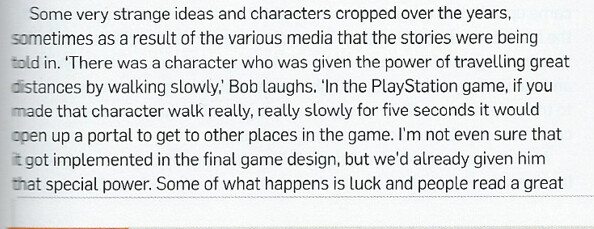
So what I get from this is that during the development of Bionicle the game (2003) they toyed with the idea of interpreting Kapura’s ability as creating a gateway to other places by walking slowly. However this never left the idea stage, as we know Bionicle the game has its own fast travel system (in this case teleportation) and even that is reduced to nigh non-existence.
So it was just one of the possible interpretations generated for a game mechanic, but unlike other ones it was never implemented. Despite that Kapura has the ability to travel quickly by walking slowly, because it was in the original story bible which of course predates the playstation game. Even if it was implemented, it wouldn’t be teleportation, because teleportation and gateways are different:
Q: Would it be safe to assume/is it possible that the making of the Kanohi Olmak involves a Teleport disk?
A: No, because that is not what the Olmak does. It opens dimensional gates – that is not the same as teleportation. Teleportation means one second you’re here, the next you’re there, with no awareness of movement – what Olmak does is dump you someplace else, that you are aware of, and then dump you out someplace else, often requiring measurable time in the intervening place.
This unused alternative interpretation retains the need for walking and physical movement. But as it was never used for anything and was just an idea, I wouldn’t use it as evidence. The rest of the data points in this analysis were used and published (except for Legend of mata Nui PC game which was only used, but not published) and they stay consistent throughout. So I am happy with the conclusions I drew.

